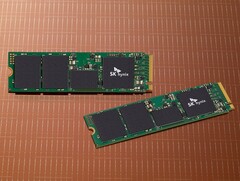
The improved memory chips can deliver up to 50% increased transfer speeds over the previous 176-layer models. With speeds reaching 2.4 Gbps per chip, a PCIe 5.0 NVMe SSD would be able to hit 14 GB/s read and write speeds.
PCIe 5.0 NVMe SSDs are now available in somewhat limited stocks, promising to double the speeds of the PCIe 4.0 models. The reality is that the new standard requires additional cooling and the existing NAND memory chips struggle to keep up with the PCIe 5.0 bandwidth. Even the fastest solution available right now like the Crucial T700 only hits 12,4 GB/s, which is still off by quite a bit from the 14 GB/s theoretical maximum speeds. Such limitations are mostly coming from the memory chips themselves, not the PCIe controllers. Thankfully, the 238-layer 4D NAND chips from SK Hynix that recently entered mass production should soon remove the bottleneck.
Premium smartphones and consumer NVMe SSDs will soon benefit from the new 238-layer 4D NAND chips, as the South Korean company has just announced that the new memory type entered mass production in late May. SK Hynix claims that the 238-layer models are the smallest NAND chips to date and have a 34% increased manufacturing efficiency over the previous gen 176-layer chips. Overall production costs should remain similar, while the competitive prices and the projected demand should drive improved earnings in the second half of 2023.
Each new chip with 238 layers can reach data transfer speeds of 2.4 Gbps, which translates to ~20% higher read and write speeds for storage solutions. With this boost, PCIe 5.0 NVMe SSDs will be able to hit 14 GB/s more consistently. SK Hynix is currently testing product compatibility with global smartphone makers and the company will start shipping the new chips in early 2H 2023.
Buy the SK Hynix Platinum P41 2TB PCIe 4.0 NMe SSD on Amazon
Related Articles
Bogdan Solca – Senior Tech Writer – 2047 articles published on Notebookcheck since 2017
I first stepped into the wondrous IT&C world when I was around seven years old. I was instantly fascinated by computerized graphics, whether they were from games or 3D applications like 3D Max. I’m also an avid reader of science fiction, an astrophysics aficionado, and a crypto geek. I started writing PC-related articles for Softpedia and a few blogs back in 2006. I joined the Notebookcheck team in the summer of 2017 and am currently a senior tech writer mostly covering processor, GPU, and laptop news.
Bogdan Solca, 2023-06- 8 (Update: 2023-06- 8)






